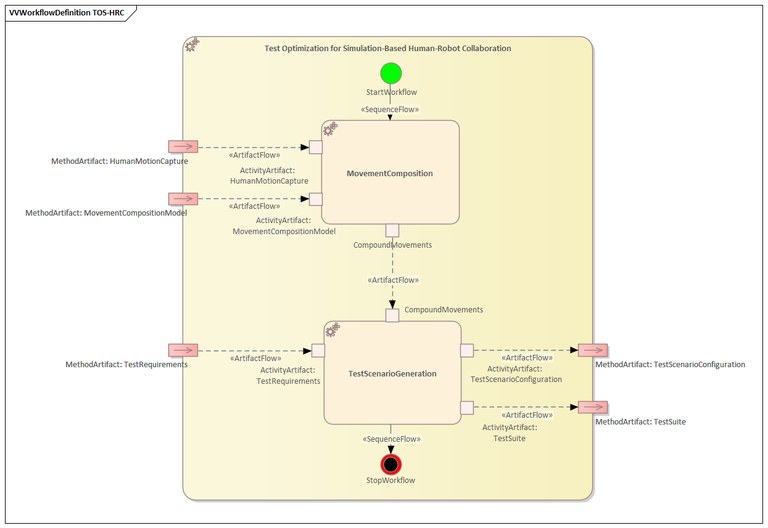Test Optimization for Simulation-based Human Robot Collaboration
Simulation-based testing is considered an effective means of testing automated systems as it allows running a larger and more complex number of test cases, testing safety-critical scenarios or specification of test oracles for the automated validation of the system [TOS-HRC1]. Although the simulation-based testing environment provides many advantages, automated simulation-based testing is still expensive and time-consuming. Therefore, test optimisation is essential to ensure efficient use of resources without sacrificing the required quality. Within this optimisation, test case generation consists of one of the primary steps [TOS-HCR2].
Test generation for human-robot collaboration
In the particular field of human-robot collaboration, the generation of test cases is challenging due to the complex and critical nature of the relationship between humans and robots. Previous works have made progress defining human worker motions that are transformed into human simulations in virtual environments (in particular for the GAZEBO environment) [TOS-HCR3]. While other studies have focused on the generation of test cases based on instructions to the robot as part of human-robot collaborative environments [TOS-HCR4].
The improvement proposed in this method consists of the generation of tests based on operator movement instructions for simulation in human-robot collaborative environments. Specifically, the proposed method improves three areas: (i) the generation of human movements, (ii) the combination of human movements and (iii) the creation of simulation scenario configurations.
The method workflow is described in the figure below.
The system receives three inputs: The base human motions and the movement composition model are provided in order to generate compound movements. Test requirements are also provided for scenario definition purposes. The movement composition subsystem takes into consideration as input the captured base human motions and the movement composition model to generate as a result a more complex and realistic compound set of movements of human workers. The test scenario generation subsystem takes as inputs the compound set of movements and test requirements to define as output both the test scenario configuration and a test suite. The requirements establish the functional and execution environment conditions for the selected test cases in the test suite. The test suite, on the other hand, consists of a subset of compound movements test cases.

TOS-HRC method workflow: Test Optimization for Simulation-Based Human-Robot Collaboration
Method artefacts:
- Inputs:
- Human Motion Captures
- Movement Composition Model
- Test Requirements
- Intermediate results
- Compound Movements
- Outputs:
- Generated Test Suite
- Test Scenario Configuration
- By using a base motion recording, a large number of variations of human movements can be generated in a collaborative robot environment.
- The generated tests can be executed both on simulation platforms and on laboratory robots.
- It allows safety-critical scenarios to be tested without putting the person at risk.
- Requires simulators and robots to be ROS compatible.
- To generate the set of base movements an initial recording is required, which depends on the domain and use case. Although movement databases exist, it may be the case that in the required domain and use case the base movements do not exist.
Addressed gaps:
- Functionality:
- [GAPM_TOS03] Generating test cases in human-robot collaboration scenarios non-automated and time-costly activity. To address this gap a test case generator will developed for the selected simulation platform.
- [TOS-HRC1] A. Arrieta, S. Wang, U. Markiegi, G. Sagardui, L. Etxeberria. “Employing Multi-Objective Search to Enhance Reactive Test Case Generation and Prioritization for Testing Industrial Cyber-Physical Systems” in IEEE Transactions on Industrial Informatics, vol. 14, no. 3, pp. 1055-1066, March 2018, DOI:10.1109/TII.2017.2788019.
- [TOS-HRC2] A. Arrieta, S. Wang, U. Markiegi, G. Sagardui and L. Etxeberria, "Search-based test case generation for Cyber-Physical Systems," 2017 IEEE Congress on Evolutionary Computation (CEC), San Sebastian, 2017, pp. 688-697, DOI: 10.1109/CEC.2017.7969377.
- [TOS-HRC3] L. He, P. Glogowski, K. Lemmerz, B. Kuhlenkötter, W. Zhang, " Method to Integrate Human Simulation into Gazebo for Human-robot Collaboration" in IOP Conference Series: Materials Science and Engineering, 2020, Vol. 825, No. 1, p. 012006DOI: 10.1088/1757-899x/825/1/012006.
- [TOS-HRC4] D. Araiza-Illan, A.G. Pipe, K. Eder, “Model-based test generation for robotic software: Automata versus belief-desire-intention agents”, 2016, arXiv preprint arXiv:1609.08439.
